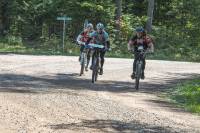On the Water: Paddling Skills for Adventure Racers
Paddling is a pillar discipline in the sport of adventure racing. Get ready to dip a blade and pull on any kind of water out on the course.
Editor’s note: This article was originally published on USARA.com and has been modified for GearJunkie.
Be it canoe, kayak, or packraft, almost every adventure race has a paddling section. And depending on your race schedule, you may need to practice flatwater paddling, whitewater techniques, or open-ocean kayaking.
Paddling in most races tends to be beginner-friendly. Think canoeing on calm water or easy river sections. In longer races, you may face ocean bays, waves, currents, and serious whitewater streams.

For beginners, the first step to becoming proficient is knowing basic strokes. You need to learn the foundations of canoe and kayak handling.
Can you keep the boat straight? Do you know how to rudder, turn, and move down a river? If yes, you’re ready for most adventure races. You don’t need to be an expert, but basic boat handling is required to effectively move through water sections on a course.
If you need to learn the basics, find a paddling course through an organization like the American Canoe Association (ACA), ask a friend with experience to teach you, and practice these skills. Mastering basic strokes will allow you to handle a boat efficiently, saving time and frustration during a race.
Navigation Required
Beyond moving the boat across water or downstream, adventure racing has the bonus and challenge of requiring navigation while you paddle. You need to both plan a course to complete a section and find checkpoints along the way.
This can be cumbersome and complex — using a map and compass while on the water is a skill set in itself. Plan to practice navigating on lakes to points, peninsulas, islands, and other major features. You should be able to discern geographic features from a map and paddle a route to reach checkpoints.
On rivers, navigation can be difficult, requiring racers to keep track of twists and turns and know where they are on the waterway. One tip: Watch for bridges, powerlines, and other major features on a map, and then use those waypoints as you paddle for a quick location check.
Use a waterproof map case and have a compass mounted on the boat or easily accessible on a lanyard. Often, the navigator should sit in the front of the boat, allowing them to see and letting a teammate in the back steer.

Gear Tips
Keeping your gear safe and dry should be a top concern. In a canoe, after a couple of miles, water will settle into the bottom of the boat from splashing and paddling. Anything on the floor will be soaked, which could include your pack.
Many teams use a large, roll-top dry bag. You can store your teams’ packs inside, sealing it up for the section. Don’t forget to keep food and water at hand for the journey downstream or across a lake.
A final point: Be sure to attach your gear to the boat. An incident where the boat tips can mean packs, bags, and gear floating away unless it is tied down.
Time to Race
What can you expect out there on a course? Paddling distances are not standard across adventure races, but most shorter races will max out at 5 miles of water time. Half-day events could have you in the boat for 10 miles, and you might hit 15-20 miles or more in a 24-hour event.
Paddling in the sport of adventure racing is a unique skill, and teams often refine it over many training days and events. Like anything, practice and time spent honing the craft are requisite for success.
But armed with the tips above — and some prep time on the water and with your gear — you should be ready to get on the water, dip a blade, and head onto the course.
This article is sponsored by Toyota. Find out more about the 2022 Toyota Tundra online.
The post On the Water: Paddling Skills for Adventure Racers appeared first on GearJunkie.




